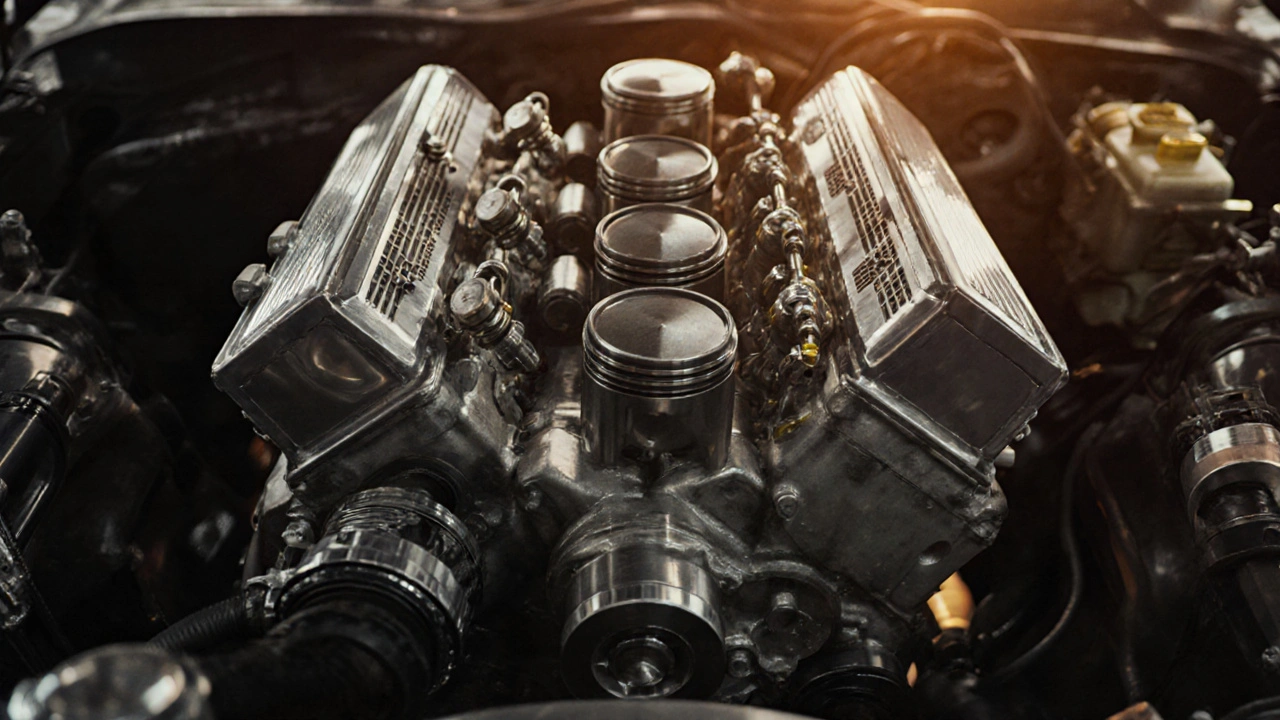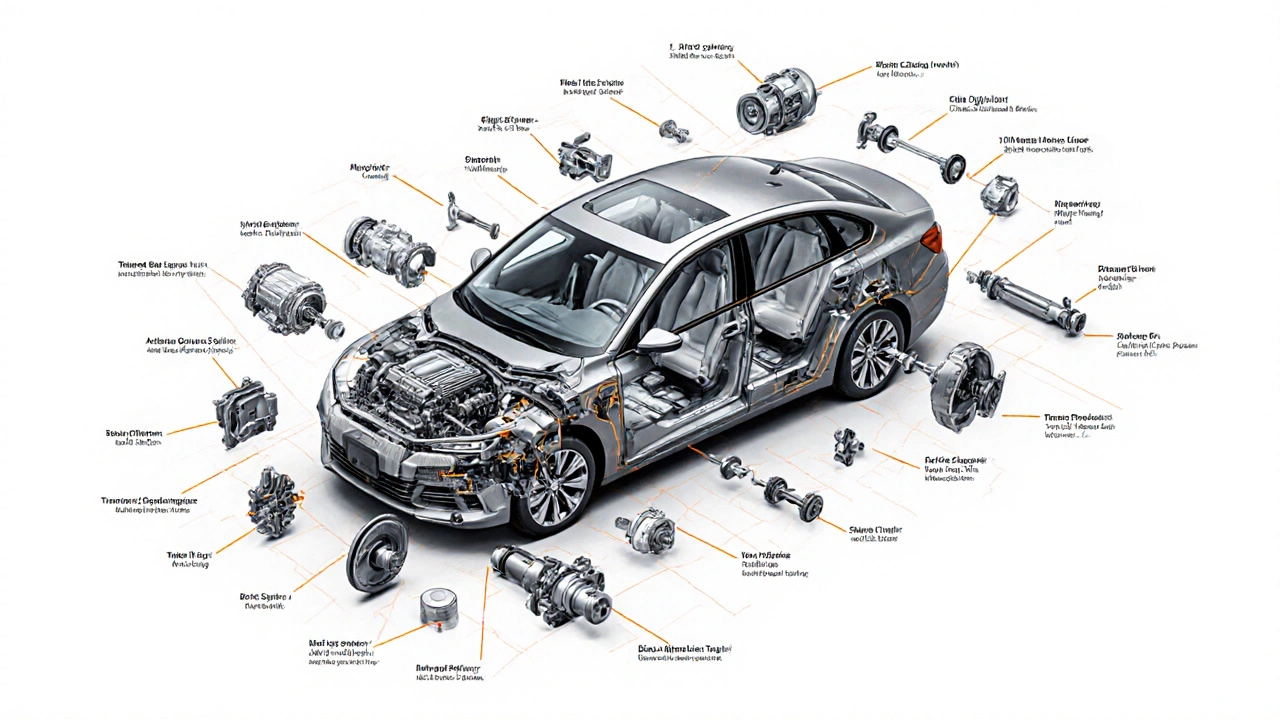Car Maintenance Reminder Calculator
Calculate your next maintenance due dates based on current mileage and engine type
Ever wonder what makes a car move, stop, and stay comfortable? Knowing the anatomy of car parts helps you spot problems early, save money on repairs, and even choose a better vehicle. Below is a down‑to‑earth guide that walks you through every major component, why it matters, and how the pieces fit together.
Quick Summary / Key Takeaways
- The engine, transmission, and drivetrain turn fuel into motion.
- Brakes, suspension, and steering keep the vehicle safe and stable.
- Electrical, fuel, and cooling systems support engine performance.
- Body and frame provide structural integrity and crash protection.
- Regular visual checks and basic maintenance can prevent costly breakdowns.
Engine - The Heart of the Vehicle
Engine is a complex mechanical unit that converts fuel into mechanical energy through controlled explosions. Most passenger cars today use four‑stroke internal‑combustion engines, but electric motors are gaining ground. Key parts include cylinders, pistons, crankshaft, camshaft, and the valve train. The bore‑stroke ratio, compression ratio, and fuel injection method determine power output and efficiency. For example, a 2.0L turbocharged gasoline engine can deliver 250hp while a 2.0L diesel of the same size may produce 180hp but with 30% better fuel economy.
When the engine misfires, you’ll hear rough idling or a loss of power. Simple checks-air‑filter condition, spark‑plug wear, and oil level-often reveal the cause.
Transmission - Delivering Power to the Wheels
Transmission is a set of gears and hydraulics that modulates engine output to match road speed and load. Manual, automatic, CVT, and dual‑clutch are the main families. A manual gearbox uses a clutch pedal and gear lever; an automatic relies on torque converters or planetary gearsets. Modern automatics can shift in under 200ms, rivaling a skilled driver’s gear changes.
Typical symptoms of transmission trouble include slipping gears, delayed engagement, or fluid leaks. Checking the transmission fluid’s color (should be pink‑red) and level can catch problems before they damage the gearbox.
Brake System - Stopping Power on Demand
Brake system is a hydraulic network that uses friction to slow or stop wheel rotation. It consists of brake pads, rotors (or drums), calipers, master cylinder, and brake fluid. Disc brakes dominate the front axle, while many older cars still use drum brakes in the rear.
Wear indicators on pads make a squealing sound when the friction material is low. Rotors can warp from excessive heat, leading to a pulsating pedal. Regularly flushing brake fluid every two years prevents moisture buildup, which can reduce boiling point and cause brake fade.
Suspension - Keeping the Ride Smooth
Suspension is a system of springs, dampers, and linkages that isolates the vehicle body from road irregularities. The most common types are MacPherson struts up front and multi‑link or trailing‑arm setups in the rear. Springs absorb bumps, while shock absorbers (or dampers) control spring oscillations.
Symptoms of worn suspension include uneven tire wear, a nose‑diving feel during braking, and a loose steering response. Visual inspection of bushings, ball joints, and strut mounts can spot cracks or excessive play.

Steering System - Guiding the Direction
Steering system is a mechanical and hydraulic assembly that translates driver input into wheel angles. Most modern cars use rack‑and‑pinion gearboxes with power assistance via hydraulic or electric systems. The steering column connects the wheel to the rack, while tie‑rods link the rack to each wheel hub.
Common issues are a steering wheel that feels loose or a whining noise when turning. Checking the power‑steering fluid level (for hydraulic systems) or scanning for error codes (for electric assist) often identifies the fault.
Exhaust System - Managing Emissions and Sound
Exhaust system is a network of pipes, catalytic converters, and mufflers that channels burned gases away from the engine and reduces pollutants. After the exhaust manifold, gases pass through a catalytic converter that transforms CO, HC, and NOx into less harmful compounds. The muffler dampens noise, while the tailpipe expels the cleaned gases.
A rattling sound near the rear can mean a loose heat shield, while a strong sulfur smell may indicate a failing catalytic converter. Visual rust checks and listening for leaks help maintain performance and keep the car legal.
Electrical System - Powering All Modern Features
Electrical system is a collection of batteries, alternators, wiring, and control modules that supply electricity to the vehicle. The 12‑V lead‑acid battery starts the engine, while the alternator recharges it and powers lights, infotainment, and sensors. Modern cars also include a Body Control Module (BCM) that manages doors, lights, and comfort functions.
Symptoms of electrical trouble range from dimming headlights to inability to start. A simple voltage test (12.6V at rest, 13.8-14.4V while running) can confirm whether the alternator is charging properly.
Fuel System - Delivering Energy Efficiently
Fuel system is a assembly of tank, pump, filter, injectors, and fuel lines that transports and meters fuel to the engine. Direct‑injection engines spray fuel directly into the combustion chamber at high pressure, improving efficiency. A clogged fuel filter can cause hard starts, while a failing fuel pump may trigger low‑fuel warnings.
Checking injector spray patterns on a test bench or monitoring fuel pressure with a gauge are common diagnostic steps for performance issues.
Cooling System - Keeping Temperatures in Check
Cooling system is a closed loop of radiator, water pump, thermostat, and coolant that regulates engine temperature. Antifreeze (typically 50% ethylene glycol) prevents freezing and raises the boiling point. The thermostat opens at around 195°F to allow coolant flow, while the water pump circulates fluid through the engine and radiator.
Overheating signs include steam from the radiator, a rising temperature gauge, or coolant loss. Regularly flushing the system every 30,000mi removes rust and deposits that can block flow.

Body & Frame - The Structural Backbone
Body and frame is a rigid structure that supports all mechanical systems and protects occupants during impacts. Modern unibody designs combine the sheet metal and frame into a single shell for weight savings. Crumple zones, side‑impact beams, and reinforced A‑pillars absorb crash energy.
Corrosion on the chassis, especially in coastal areas, can weaken structural integrity. Spot‑checking for rust around wheel wells, undercarriage, and door sills helps maintain safety.
Engine Type Comparison
| Attribute | Gasoline | Diesel | Electric | Hybrid |
|---|---|---|---|---|
| Typical Efficiency (MPG‑equiv) | 25‑30 | 30‑40 | 100‑120 | 30‑45 |
| Peak Torque (Nm) | 250‑300 | 400‑600 | 300‑500 | 350‑550 |
| Emissions | CO₂, NOx | NOx, PM | Zero tailpipe | Reduced CO₂ |
| Maintenance Intervals | 5,000mi | 7,500mi | 15,000mi | 5,000‑7,500mi |
| Typical Cost (USD) | $20‑30k | $25‑35k | $35‑45k | $30‑40k |
Basic Maintenance Checklist for All Car Parts
- Engine oil level & condition - check monthly, change every 5,000mi.
- Transmission fluid - inspect level and color; replace per manufacturer schedule.
- Brake pads & rotors - visual wear >3mm warrants replacement.
- Suspension bushings and shocks - look for cracks, leakage, or excessive play.
- Steering fluid (hydraulic) or error codes (electric) - verify levels and system alerts.
- Exhaust system - listen for rattles and inspect for rust or broken hangers.
- Battery voltage and terminal corrosion - clean contacts, replace every 4‑5years.
- Fuel filter - replace every 30,000mi for gasoline, 40,000mi for diesel.
- Coolant level and mixture - check reservoir, flush every 30,000mi.
- Body/frame rust - touch‑up paint or undercoating in high‑risk zones.
Frequently Asked Questions
How often should I change my engine oil?
Most modern cars with synthetic oil can go 7,500 to 10,000mi between changes, but checking the owner’s manual is essential. If you drive in severe conditions (dust, short trips, towing), stick to the 5,000‑mi interval.
What’s the difference between disc and drum brakes?
Disc brakes use a caliper to squeeze brake pads against a rotating disc, offering better heat dissipation and consistent performance. Drum brakes press shoes against the inner surface of a drum; they’re cheaper but more prone to fade under heavy use.
Can I replace a cracked engine block myself?
A cracked block usually means the engine needs a full rebuild or replacement. It’s a job for a professional machine shop because it involves machining, torquing to precise specifications, and checking for internal damage.
Why does my car shake at high speeds?
High‑speed vibration is often caused by unbalanced wheels, worn suspension bushings, or a warped brake rotor. Start by balancing the tires and then inspect the suspension components for wear.
Is synthetic coolant better than traditional coolant?
Synthetic (OAT) coolants last longer-typically 150,000mi or 5years-because they resist corrosion better than conventional green antifreeze, which needs changing every 30,000mi.
Next Steps
Pick one area you feel least confident about-maybe the brake pads or the cooling system-and do a visual inspection this weekend. If anything looks worn, replace it before it causes a bigger problem. For complex tasks like engine rebuilds, book a reputable shop and ask about warranties. Keeping a simple log of mileage, service dates, and any odd noises will make future troubleshooting much easier.
Understanding the anatomy of car parts turns a baffling machine into a collection of logical pieces you can watch, maintain, and, when needed, repair. Happy driving!






amber hopman
October 10, 2025 AT 17:27I love how the article breaks down each component like the oil system and the brake pads. It really helps newbies see why regular oil checks can save you a ton of cash. Also, the tip about consulting the owner’s manual is spot on – manufacturers love to hide the good stuff in there. Bottom line: stay on top of those intervals and your ride will thank you.
Jim Sonntag
October 12, 2025 AT 04:15Wow, a calculator for car maintenance. Because we all have time to sit and enter mileage instead of just guessing when the check‑engine light flickers.
Deepak Sungra
October 13, 2025 AT 15:03Bro, the brake pads thing hit different. I swear they squeal like a haunted karaoke bar every 5k miles. And don’t get me started on the transmission fluid – it’s basically the lifeblood, but we treat it like a cheap latte. Keep an eye on those levels or you’ll be crashing faster than my Wi‑Fi on a rainy day.
Samar Omar
October 15, 2025 AT 01:51When one contemplates the intricate tapestry of automotive engineering, one cannot help but be reminded of the profound symbiosis between form and function. The engine oil, that viscous amber elixir, performs a silent ballet, lubricating piston crowns while whisking away thermal excess. Equally paramount is the transmission fluid, a tenacious coolant that endures the torque’s relentless demands, ensuring seamless gear transitions. The brake pads, those sacrificial sentinels, convert kinetic chaos into frictional harmony, a testament to controlled deceleration. Let us not overlook the coolant system, a circulatory network that precludes catastrophic overheating, a veritable lifeline for the combustion heart. Each subsystem, while ostensibly discrete, coalesces into an orchestral masterpiece that propels the automobile from inertness to motion. The author’s inclusion of an online maintenance calculator is, undeniably, a nod to the digital zeitgeist, yet one must remain vigilant that such tools supplement, not supplant, tactile inspection. In the grandiloquent pursuit of vehicular longevity, the owner’s manual remains the definitive codex, a repository of manufacturer wisdom often eschewed by the cavalier driver. It is incumbent upon the diligent custodian to peruse these pages, to excavate the nuanced service intervals concealed within. Moreover, the juxtaposition of analog intuition and algorithmic precision engenders a hybrid paradigm, wherein empirical experience dovetails with computational foresight. As the odometer accrues mileage, the symphonic interplay of oil, fluid, pads, and coolant must be choreographed with meticulous regularity. Failure to honor this rhythm precipitates a cascade of mechanical maladies, each more lamentable than the last. Thus, the reader is behooved to adopt a regimen of periodic checks, lest the vehicle’s erstwhile vigor wane under neglect. In summation, the anatomy of car parts is not mere technical jargon; it is an ode to engineered resilience, a testament to human ingenuity harnessed within steel and rubber. Let the diligent driver heed this clarion call, for in doing so, they secure both safety and the unbridled joy of the open road.
chioma okwara
October 16, 2025 AT 12:39the coolant reservoir cap should never be ovrtightened.
John Fox
October 17, 2025 AT 23:27yeah, it’s kinda cool when you can just punch in miles and get a reminder.
Tasha Hernandez
October 19, 2025 AT 10:15Oh brilliant, because nothing screams "I’m a responsible adult" like a neon‑green button on a webpage. If only my car could feel the sarcasm, maybe it’d finally stop ignoring my frantic brake‑pad prayers.
Anuj Kumar
October 20, 2025 AT 21:03Sure, but the real secret is that the oil change schedule is a conspiracy by the oil majors to keep us buying more.